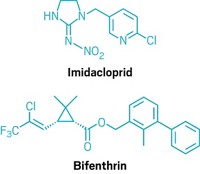Advertisement
Grab your lab coat. Let's get started
Welcome!
Welcome!
Create an account below to get 6 C&EN articles per month, receive newsletters and more - all free.
It seems this is your first time logging in online. Please enter the following information to continue.
As an ACS member you automatically get access to this site. All we need is few more details to create your reading experience.
Not you? Sign in with a different account.
Not you? Sign in with a different account.
ERROR 1
ERROR 1
ERROR 2
ERROR 2
ERROR 2
ERROR 2
ERROR 2
Password and Confirm password must match.
If you have an ACS member number, please enter it here so we can link this account to your membership. (optional)
ERROR 2
ACS values your privacy. By submitting your information, you are gaining access to C&EN and subscribing to our weekly newsletter. We use the information you provide to make your reading experience better, and we will never sell your data to third party members.
Biological Chemistry
Insecticidal protein protects against western corn rootworms
DuPont Pioneer researchers help combat the budding problem of resistance to insecticides produced by GM crops
by Ryan Cross
September 26, 2016
| A version of this story appeared in
Volume 94, Issue 38
Genetically modified (GM) crops often require fewer pesticides compared with their conventional counterparts, thanks to their engineered ability to produce their own insecticides, a trait derived from the bacterium Bacillus thuringiensis (Bt). But insects such as the western corn rootworm are developing resistance to commonly used Bt insecticides, allowing them to happily munch their way through crop roots. Eager for a fresh combat strategy against corn rootworm, scientists at DuPont Pioneer began digging through the dirt to discover potent new insecticides produced by soil bacteria. They found IPD072Aa, a previously unknown protein produced by Pseudomonas chloroaphis (Science 2016, DOI: 10.1126/science.aaf6056). After inserting the gene for IPD072Aa into corn, the researchers found that their plants were effective at killing corn rootworm larvae, even if those larvae were resistant to Bt corn. Tom Greene, a research director who oversaw the work, says this “opens the door to new insecticidal proteins that potentially represent new modes of action.” Greene anticipates IPD072Aa working synergistically with Bt insecticides in future seed products.




Join the conversation
Contact the reporter
Submit a Letter to the Editor for publication
Engage with us on Twitter